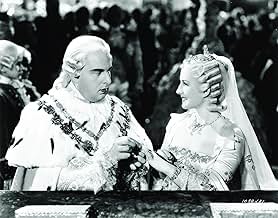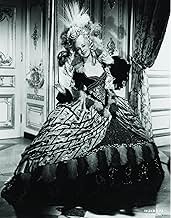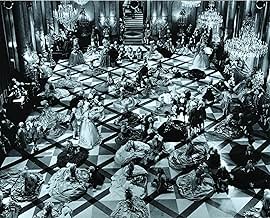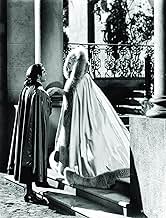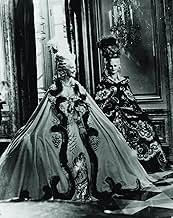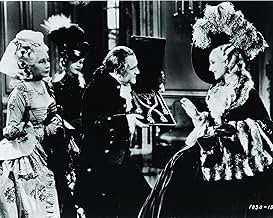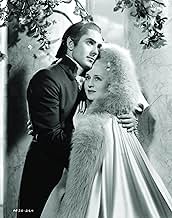AVALIAÇÃO DA IMDb
7,3/10
3,5 mil
SUA AVALIAÇÃO
Adicionar um enredo no seu idiomaThe tragic life of Marie Antoinette, who became queen of France in her late teens.The tragic life of Marie Antoinette, who became queen of France in her late teens.The tragic life of Marie Antoinette, who became queen of France in her late teens.
- Direção
- Roteiristas
- Artistas
- Indicado a 4 Oscars
- 5 vitórias e 5 indicações no total
Albert Dekker
- Comte de Provence
- (as Albert Van Dekker)
Avaliações em destaque
As a young actress still in her 20s, Norma Shearer was hailed as the First Lady of MGM, and she reigned as queen of the studio throughout the 1930s. For about two decades after early retiring in 1942, she was fondly remembered by fans and critics, but slowly she was mostly forgotten. Then in the early 70s, antagonistic film critic Pauline Kael, grudge-holding MGM rival Joan Crawford and others took delight in trashing her, usually with the implication that Norma's greatest talent was finding a powerful husband (Irving Thalberg). Unfortunately, those unfair remarks carried great weight since Shearer's movies were unavailable on video and rarely shown on TV.
We're now able to see her talent for ourselves, thanks largely to Turner Classic Movies, and Norma Shearer's star is rising again.
If you've never seen a Shearer movie, Marie Antoinette is a good beginning. It is one of Hollywood's great epics of the 1930s, with lavish costumes and scenery, and its historic setting holds up well. Shearer plays the doomed French queen from teenager to the Guillotine, and the final scenes as she awaits death in prison are among the finest of her career.
In recent years, Shearer has gained new respect for her silent and pre-code films, in which she was one of the most accomplished young actresses of the era. She often played sexually sophisticated women with a sly wit. She was not a typical ingénue, and you can see why audiences of the time were enchanted by her.
We're now able to see her talent for ourselves, thanks largely to Turner Classic Movies, and Norma Shearer's star is rising again.
If you've never seen a Shearer movie, Marie Antoinette is a good beginning. It is one of Hollywood's great epics of the 1930s, with lavish costumes and scenery, and its historic setting holds up well. Shearer plays the doomed French queen from teenager to the Guillotine, and the final scenes as she awaits death in prison are among the finest of her career.
In recent years, Shearer has gained new respect for her silent and pre-code films, in which she was one of the most accomplished young actresses of the era. She often played sexually sophisticated women with a sly wit. She was not a typical ingénue, and you can see why audiences of the time were enchanted by her.
MGM's lavishly budgeted look at the French Revolution during the reign of King Louis and his famously selfish MARIE ANTOINETTE spares no expense in detailing the grim background of court conspiracies and the people's unrest that led to their downfall.
Too bad none of this eye-popping splendor wasn't captured in Technicolor, as originally planned--but with a budget well over 1.5 million it was decided to film it in glorious B&W. No matter, it's still a spectacle for sore eyes.
There can be no doubt about NORMA SHEARER's triumph in the title role nor is any of the acting in the large cast below standard. ROBERT MORLEY as the weak and indecisive Louis is immensely touching and effective as he realizes the gravity of their predicament. JOHN BARRYMORE is fine and Joseph SCHILDKRAUT is wonderful as an aristocratic fop. TYRONE POWER lends his romantic presence to a role that requires little more than his good looks. He and Shearer make a physically appealing romantic team.
It's interesting that Irving Thalberg died before production began on the film. One wonders whether his influence on it might have made it an even stronger production. There are definite lulls in the telling but it builds dramatically to all of the final scenes. It's the kind of film that leads one to read more about the actual events and that's always a good thing.
Summing up: Sumptuously produced, well acted and well directed--what more could you want for an interesting glimpse of a life of royalty among a time of social upheaval? Shearer's triumphant return to the screen after a two-year absence.
Too bad none of this eye-popping splendor wasn't captured in Technicolor, as originally planned--but with a budget well over 1.5 million it was decided to film it in glorious B&W. No matter, it's still a spectacle for sore eyes.
There can be no doubt about NORMA SHEARER's triumph in the title role nor is any of the acting in the large cast below standard. ROBERT MORLEY as the weak and indecisive Louis is immensely touching and effective as he realizes the gravity of their predicament. JOHN BARRYMORE is fine and Joseph SCHILDKRAUT is wonderful as an aristocratic fop. TYRONE POWER lends his romantic presence to a role that requires little more than his good looks. He and Shearer make a physically appealing romantic team.
It's interesting that Irving Thalberg died before production began on the film. One wonders whether his influence on it might have made it an even stronger production. There are definite lulls in the telling but it builds dramatically to all of the final scenes. It's the kind of film that leads one to read more about the actual events and that's always a good thing.
Summing up: Sumptuously produced, well acted and well directed--what more could you want for an interesting glimpse of a life of royalty among a time of social upheaval? Shearer's triumphant return to the screen after a two-year absence.
This movie will probably never be excelled largely because of the casting. I don't believe that anyone will ever find better actors or actresses to portray King Louis XVI and Queen Marie Antoinette than Robert Morley and Norma Shearer. The black and white aspect of this great classic film is simply spell binding in its interpretation of the life of the Royal Family. Color will give it a different dimension. The manner in which the conflict of the ensuing mob marching upon the Versailles is well portrayed. I especially like the sense of paranoia and fear that grip the Queen and her entourage. The use of the outside gate is especially endearing to me, reminding me why it is that King Louis XIV created the Château d' Versailles in such a distance from Paris. Unless one knows the history of the Château, nobody can truly appreciate the march of the Faubourgs. Excellent film, and I recommend seeing it before any other on the same subject!
It never ceases to amaze me at how completely I might be suddenly drawn into the emotional moment of a film by the power of the actor. Usually the strongest ones come suddenly, and without warning, giving you no time to put up defenses. Brando's eruptions of moods when talking to his dead wife in Last Tango in Paris is probably the most dramatic example of this. (His greatest scene ever, that I have witnessed) But before that, Norma Shearer's panic and utter emotional breakdown when the guards come to take her son from her in the prison, is overwhelming and complete. Anyone who is not genuinely moved to the core by this incredible performance, either sleeps or does not possess those human sensitivities that are torn by the loss of a child. For it is not sympathy that is evoked, but an empathy called forth by the raw, human agony of the suffering before you. Years later when I visited the actual site in Paris where that tragedy would have taken place, I experienced a time of respect and reflection such as I have never had in any other place in the world that I have visited.
This is one of the truly great films. If you want to find out how deeply someone can feel, show it to them and observe. Norma Shearer set a standard I fear has been forgotten, as evidenced by the way tinsel town hands out awards today for mediocre work pushed onto the modern consciousness by glitzy ad campaigns and self-serving accolades.
This is one of the truly great films. If you want to find out how deeply someone can feel, show it to them and observe. Norma Shearer set a standard I fear has been forgotten, as evidenced by the way tinsel town hands out awards today for mediocre work pushed onto the modern consciousness by glitzy ad campaigns and self-serving accolades.
This film boasts a number of wonderful performances and is a great example of film acting in the thirties and the power of the studios. Robert Morley steals the show as Louis XVI, but equally fine are John Barrymore as the dying Louis XV, Gladys George as Madame du Barry, Joseph Schildkraut as the Duke of Orleans and a whole slew of wonderful character actors who enlivened even the smallest role. Norma Shearer admirably tackles the nearly impossible task of portraying the life of Marie Antoinette from a young girl to a broken woman on her way to the guillotine. In the style of the time, the film has a tendency toward histrionics but for the viewer with patience the overall effect is fascinating. Of special interest to students of art direction. The sets and costumes are incredible.
Você sabia?
- CuriosidadesAccording to Wikipedia, the movie had thousands of costumes and lavish set designs. Adrian visited France and Austria in 1937 researching the period. He studied the paintings of Marie Antoinette, even using a microscope on them so that the embroidery and fabric could be identical. Fabrics were specially woven and embroidered with stitches sometimes too fine to be seen with the naked eye. The attention to detail was extreme, from the framework to hair. Some gowns became extremely heavy due to the embroidery, flounces and precious stones used. Norma Shearer's gowns alone had a combined weight of over 1,768 lb., the heaviest being the wedding dress.
- Erros de gravaçãoAt the time of their wedding, the Dauphin, Louis, was 15 and Marie Antoinette was 14. Norma Shearer could (barely) get away with portraying a 14-year-old (as she portrayed a 13-year-old Juliet in ROMEO AND JULIET (1936) because many noble/royal females were more mature and had regal bearing), but Robert Morley looked 35, not 15.
- Citações
Marie Antoinette: I once thought if I were queen, I'd be so happy. To be applauded and adored and obeyed. I don't want it now. I just want to be free. To be with you. To love you. I cannot wear a crown upon my heart.
- Versões alternativas"Unrestored" film has now been restored and is available on DVD. When the film played the Carthay Circle in Los Angeles and the Astor Theatre in New York as a reserved seat "road show" attraction, the print ran eleven minutes longer than the generally available 149 minute Turner Library print. These eleven minutes contained an overture, entr'acte, and exit music, with an intermission immediately following Antoinette's emotional farewell to Fersen on the steps of Versailles. These remnants of the "road show" presentation have now been restored to the new Warner Bros. Home Video DVD, which runs a little over 157 minutes.
- ConexõesEdited into Hollywood: The Dream Factory (1972)
Principais escolhas
Faça login para avaliar e ver a lista de recomendações personalizadas
- How long is Marie Antoinette?Fornecido pela Alexa
Detalhes
- Data de lançamento
- País de origem
- Idioma
- Também conhecido como
- María Antonieta
- Locações de filme
- Chateau de Versailles, Versailles, Yvelines, França(palace backgrounds)
- Empresa de produção
- Consulte mais créditos da empresa na IMDbPro
Bilheteria
- Orçamento
- US$ 2.926.000 (estimativa)
- Tempo de duração2 horas 29 minutos
- Proporção
- 1.37 : 1
Contribua para esta página
Sugerir uma alteração ou adicionar conteúdo ausente


